Introduction
Heart disease becomes more and more common in our daily life and there are a lot of reasons that are possible to cause it. Here in this simple study, we are going to use classification methods, logistic regression and KNN, to predict whether a patient has heart disease or not.
Click here for the code and data
Data Description
This database comes from Kaggle, which contains 303 data points in total.
Features:
- age - age in years
- sex - (1 = male; 0 = female)
- cp - chest pain type
- trestbps - resting blood pressure (in mm Hg on admission to the hospital)
- chol - serum cholestoral in mg/dl
- fbs - (fasting blood sugar > 120 mg/dl) (1 = true; 0 = false)
- restecg - resting electrocardiographic results
- thalach - maximum heart rate achieved
- exang - exercise induced angina (1 = yes; 0 = no)
- oldpeak - ST depression induced by exercise relative to rest
- slope - the slope of the peak exercise ST segment
- ca - number of major vessels (0-3) colored by flourosopy
- thal - 3 = normal; 6 = fixed defect; 7 = reversable defect
- target - have disease or not (1=yes, 0=no)
Analysis
Brief Data Exploration
import numpy as np
import pandas as pd
import matplotlib.pyplot as plt
import seaborn as sns
from sklearn.linear_model import LogisticRegression
from sklearn.model_selection import train_test_split
from sklearn import metrics
import os
df=pd.read_csv("C:\Documents\Microeconometrics\Assignments3\heart-disease-uci/heart.csv")
df.head()
| age | sex | cp | trestbps | chol | fbs | restecg | thalach | exang | oldpeak | slope | ca | thal | target | |
|---|---|---|---|---|---|---|---|---|---|---|---|---|---|---|
| 0 | 63 | 1 | 3 | 145 | 233 | 1 | 0 | 150 | 0 | 2.3 | 0 | 0 | 1 | 1 |
| 1 | 37 | 1 | 2 | 130 | 250 | 0 | 1 | 187 | 0 | 3.5 | 0 | 0 | 2 | 1 |
| 2 | 41 | 0 | 1 | 130 | 204 | 0 | 0 | 172 | 0 | 1.4 | 2 | 0 | 2 | 1 |
| 3 | 56 | 1 | 1 | 120 | 236 | 0 | 1 | 178 | 0 | 0.8 | 2 | 0 | 2 | 1 |
| 4 | 57 | 0 | 0 | 120 | 354 | 0 | 1 | 163 | 1 | 0.6 | 2 | 0 | 2 | 1 |
sns.countplot(x="target", data=df)
plt.show()
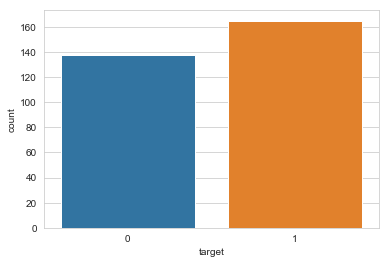
pd.crosstab(df.age,df.target).plot(kind="bar",figsize=(20,6))
plt.title('Heart Disease Frequency for Ages')
plt.xlabel('Age')
plt.ylabel('Frequency')
plt.show()
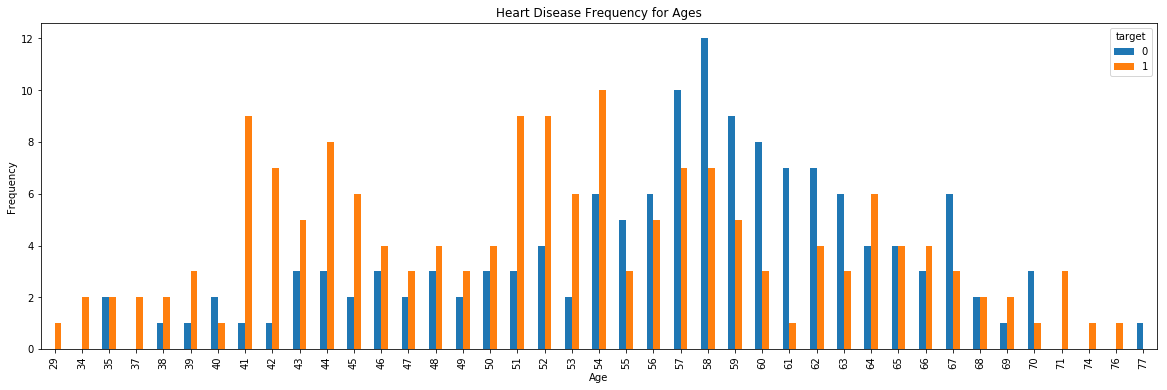
pd.crosstab(df.sex,df.target).plot(kind="bar",figsize=(15,6))
plt.title('Heart Disease Frequency for Sex')
plt.xlabel('Sex (0 = Female, 1 = Male)')
plt.xticks(rotation=0)
plt.ylabel('Frequency')
plt.show()
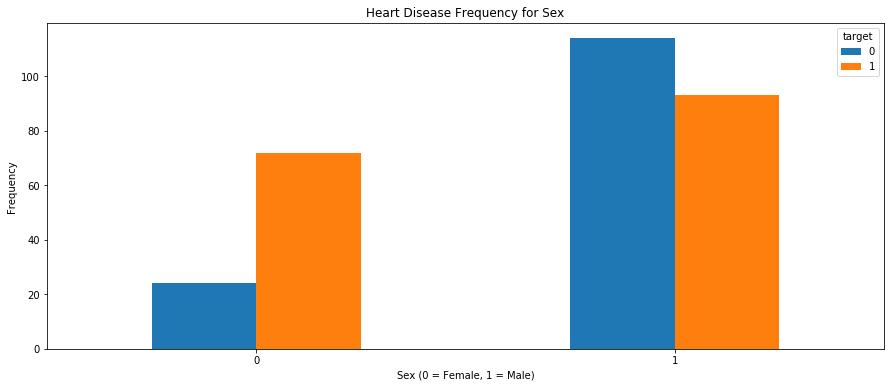
pd.crosstab(df.cp,df.target).plot(kind="bar",figsize=(15,6))
plt.title('Heart Disease Frequency According To Chest Pain Type')
plt.xlabel('Chest Pain Type')
plt.xticks(rotation = 0)
plt.ylabel('Frequency of Disease or Not')
plt.show()
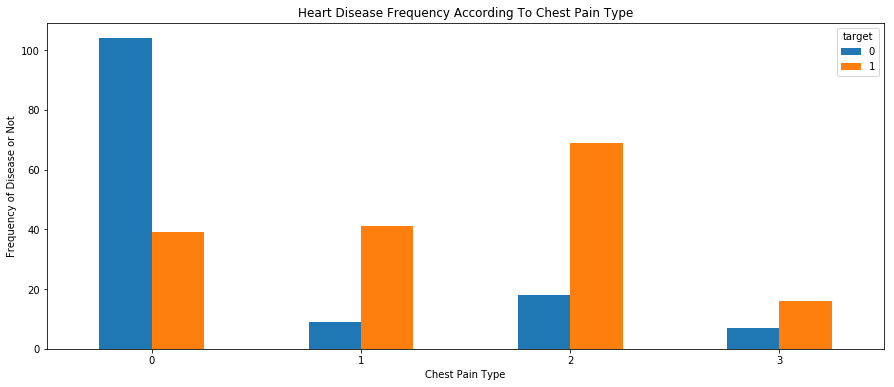
Data Transformation
We are going to transform “cp”, “thal” and “slope” into dummy variables for more convenient analysis.
a = pd.get_dummies(df['cp'], prefix = "cp")
b = pd.get_dummies(df['thal'], prefix = "thal")
c = pd.get_dummies(df['slope'], prefix = "slope")
frames = [df, a, b, c]
df = pd.concat(frames, axis = 1)
df = df.drop(columns = ['cp', 'thal', 'slope'])
df.head()
| age | sex | trestbps | chol | fbs | restecg | thalach | exang | oldpeak | ca | ... | cp_1 | cp_2 | cp_3 | thal_0 | thal_1 | thal_2 | thal_3 | slope_0 | slope_1 | slope_2 | |
|---|---|---|---|---|---|---|---|---|---|---|---|---|---|---|---|---|---|---|---|---|---|
| 0 | 63 | 1 | 145 | 233 | 1 | 0 | 150 | 0 | 2.3 | 0 | ... | 0 | 0 | 1 | 0 | 1 | 0 | 0 | 1 | 0 | 0 |
| 1 | 37 | 1 | 130 | 250 | 0 | 1 | 187 | 0 | 3.5 | 0 | ... | 0 | 1 | 0 | 0 | 0 | 1 | 0 | 1 | 0 | 0 |
| 2 | 41 | 0 | 130 | 204 | 0 | 0 | 172 | 0 | 1.4 | 0 | ... | 1 | 0 | 0 | 0 | 0 | 1 | 0 | 0 | 0 | 1 |
| 3 | 56 | 1 | 120 | 236 | 0 | 1 | 178 | 0 | 0.8 | 0 | ... | 1 | 0 | 0 | 0 | 0 | 1 | 0 | 0 | 0 | 1 |
| 4 | 57 | 0 | 120 | 354 | 0 | 1 | 163 | 1 | 0.6 | 0 | ... | 0 | 0 | 0 | 0 | 0 | 1 | 0 | 0 | 0 | 1 |
5 rows × 22 columns
Logistic Regression
y=df.target.values
x_data=df.drop(['target'],axis=1)
#Normalize
x = (x_data - np.min(x_data)) / (np.max(x_data) - np.min(x_data)).values
#Splitting training and testing data
x_train, x_test, y_train, y_test = train_test_split(x, y, test_size=0.2, random_state=0)
logreg = LogisticRegression()
logreg.fit(x_train, y_train)
LogisticRegression(C=1.0, class_weight=None, dual=False, fit_intercept=True,
intercept_scaling=1, max_iter=100, multi_class='warn',
n_jobs=None, penalty='l2', random_state=None, solver='warn',
tol=0.0001, verbose=0, warm_start=False)
y_pred = logreg.predict(x_test)
print('Accuracy of logistic regression on test set: {:.2f}'.format(logreg.score(x_test, y_test)))
Accuracy of logistic regression classifier on test set: 0.87
K-Nearest Neighbor Classification (KNN)
from sklearn.neighbors import KNeighborsClassifier
knn = KNeighborsClassifier(n_neighbors = 5)
knn.fit(x_train, y_train)
prediction = knn.predict(x_test)
print("Accuracy of {} NN Score on test set: {:.2f}".format(5, knn.score(x_test, y_test)))
Accuracy of 5 NN Score on test set: 0.85
# find the best K
scoreList = []
for i in range(1,20):
knn2 = KNeighborsClassifier(n_neighbors = i)
knn2.fit(x_train, y_train)
scoreList.append(knn2.score(x_test, y_test))
plt.plot(range(1,20), scoreList)
plt.xticks(np.arange(1,20,1))
plt.xlabel("K value")
plt.ylabel("Score")
plt.show()
print("Maximum KNN Score is {:.2f}".format((max(scoreList))))
print("The best K is 3, 7 and 8")
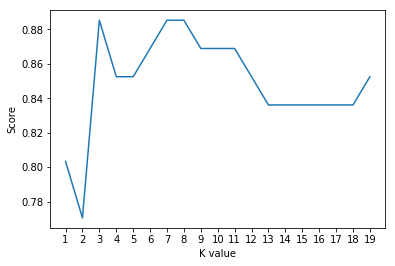
Maximum KNN Score is 0.89
The best K is 3, 7 and 8
Comparing the Two Models
#Accuracy
methods = ["Logistic Regression", "KNN"]
accuracy=[0.87,0.89]
sns.set_style("whitegrid")
plt.ylabel("Accuracy")
plt.xlabel("Models")
sns.barplot(x=methods, y=accuracy)
plt.show()
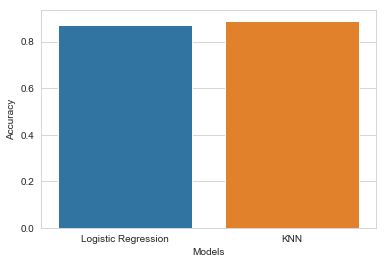
#Confusion matrix
from sklearn.metrics import confusion_matrix
y_head_lr = logreg.predict(x_test)
knn3 = KNeighborsClassifier(n_neighbors = 3)
knn3.fit(x_train, y_train)
y_head_knn = knn3.predict(x_test)
cm_lr = confusion_matrix(y_test,y_head_lr)
cm_knn = confusion_matrix(y_test,y_head_knn)
plt.figure(figsize=(15,6))
plt.suptitle("Confusion Matrixes",fontsize=24)
plt.subplots_adjust(wspace = 0.4, hspace=0.4)
plt.subplot(1,2,1)
plt.title("Logistic Regression Confusion Matrix")
sns.heatmap(cm_lr,annot=True,cmap="Blues",fmt="d",cbar=False)
plt.subplot(1,2,2)
plt.title("KNN Confusion Matrix K=3")
sns.heatmap(cm_knn,annot=True,cmap="Blues",fmt="d",cbar=False)
plt.show()
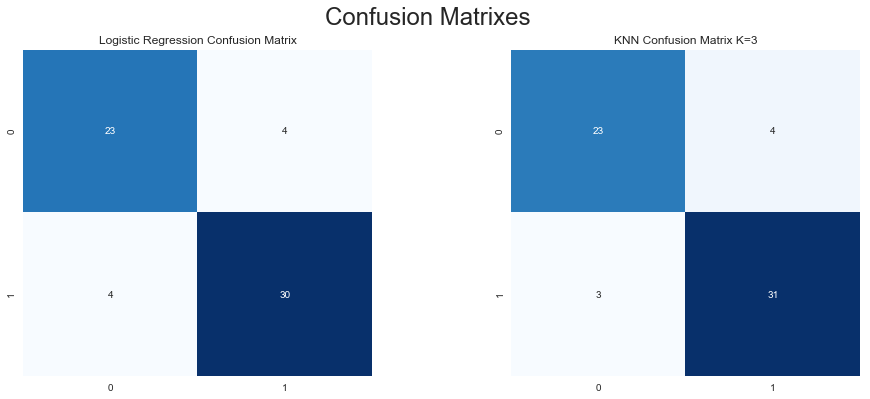
According to accuracy and confusion matrix above, we can see that both models work well with the data but KNN is slightly better. Therefore, we choose KNN (K=3) as the final model to predict if a patient have heart disease or not.
Reference
Building A Logistic Regression in Python, Step by Step
Heart Disease - Classifications (Machine Learning) in Kaggle